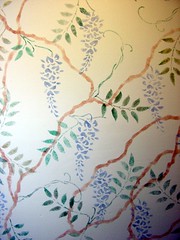A few years ago, after painting the inside of the house, I stencilled some of the walls. Lyn Le Grice's book, The Stencilled House, was one inspiration, Early American Stencils by Janet Waring another. As opposed to wallpaper, you can paint out your stencilling mistakes, but I also like the different effects you can produce.
I cut some stencils myself, and bought a couple of commercial ones.
This wall (in a very small room, 'nuff said) used a Jocasta Innes stencil pack - it included the cut stencils, but the layout using these elements was up to you. So I just started in one bottom corner and stencilled the branches of a wisteria up the wall, then added the flowers and leaves.
By the time I did this one I'd learned how little paint you should have on the brush (almost dry), I'd discovered adhesive spray (so the stencils stuck and bleed was minimal), I'd experimented enough to know about layering colours (for depth) and I was prepared to have fun covering a 3' x 8' wall with wisteria.
And I did. And several years later, it's still a pleasing corner of this home. I've also used stencilling on paper and fabric - it's a great craft technique.
In colonial America, stencilling was a cheaper option than wallpaper, executed by travelling artisans such as Moses Eaton. You can see a bunch of his designs here. While I'm happy with the freeform of the wisteria for a full (small) wall, I used some of this style in other rooms- love their simplicity.
Haven't painted over any of it.... (well, just to fix goofs!). While I can be inspired by Moses Eaton, I am an admirer, but not an imitator, of the early American wall murals of Rufus Porter. All part of my wider affection for the simple grace of early American colonial interiors.








No comments:
Post a Comment